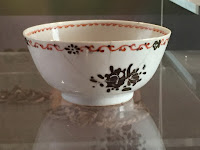A few months ago while traveling in Australia I was inspired by some of the ways archaeology was featured on the streets, incorporated into the architecture, and featured on display at various historical sites.
1. From the Street
This panel looks small but took up an exterior wall above a busy covered sidewalk on George Street close to the Rocks. Archaeology had been done in advance of street improvements on the site, and this looked like an honest effort from the contractors to show what archaeologists found out as a result of their excavation. I'd LOVE to see more urban archaeology displays like this in the cities I visit.
 |
| Overall panel. |
 |
| Close up on maritime industries, economic tie to the area. Project area in red. |
 |
| Close up of the project area location on historic drawing. |
 |
| Tools attributed to the Gadigal, Sydney Cove's first inhabitants, found in the lower layers and predate European settlement. |
 |
| I did look up the site- for more on the project see the GML website. |
2. Integrated into the Architecture
The scale of the next example is difficult to illustrate, but from the pictures you can see the Youth Hostel with silver screens raised in front of the structure. The screens illustrated the size and scale of a former structure left intact UNDER the contemporary building. For more on the site, check out the
Big Dig Archaeology Education Centre website.
 |
| View from the street. |
 |
| Open features in situ with wire horse and silver standing screen to illustrated architecture. |
 |
| Panels and maps help orient the visit to the site. |
 |
| Cleaver use of wire sculptures to illustrate livestock, note Big Dig Archaeology Education Centre in the background. |
 |
| More views of interpretation for the public at the YHA site. |
 |
| Artifact cases feature ceramics, glass, and personal objects of various materials found during excavation. |
 |
| More open features and interpretation under the main YHA structure. |
 |
| Chain mail coin purse. |
 |
| Personal objects such as tooth brushes, syringe, pins, and studs. |
3. Artifacts Big and Small on Display
In both Sydney and Canberra we saw archaeology featured prominently in house and national museums.
Cadmans Cottage (1816), oldest standing structure in Sydney.


I saw my one and only headstone in Australia at the Rocks Discovery Museum, that of George Graves died 1768. I also learned what a Sailor's Palm was, something like a thimble worn on the pal, to push needles through sailcloth. Many of the domestic artifacts were familiar to me, as ceramics and glass found in Australia and America had British origins. The kids section featured a "Make Your Own Exhibit" activity capitalizing on the educational value of objects. Finally, up on the top floor the museum exhibited works from an annual reconciliation art challenge. Out of respect for the artists I took no photos except of the promotional flier. But it was really the first time I saw the theme of reconciliation explained, and the theme continued throughout all other natural and cultural places we visited. A few of what we in the US would call prehistoric artifacts were on display. The canoe and stone tool styles looked completely foreign to me.
National Museum of Australia in Canberra
The
National Museum of Australia in Canberra featured two displays I'd like to mention here. One is a display featuring John Mulvaney's tools, considered the father of Australian Archaeology. While I was impressed with the screen and trowel on exhibit, in my search for a better picture I found 58 objects once made or used by John Mulvaney (
check 'em out!). The other exhibit I found fascinating was over 300 convict love tokens on dark display (literally, some of the lights were not on). Prepare to be disappointed by my shots from the museum, but on an extremely positive note the museum has a fantastic interactive
Convict Love Tokens website where you can learn more about these endearingly personal, modified objects.
 |
| Just one of the 58 objects owned by the museum by John Mulvaney. |
 |
| Convict Love Tokens on display |
Told you- you're gonna wanna visit the
Convict Love Tokens website to get a better look.
Text and Photos: Sarah Miller, FPAN Staff






































